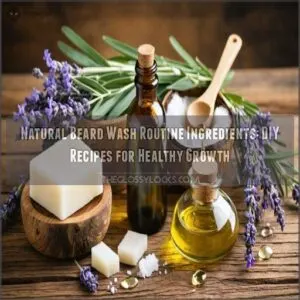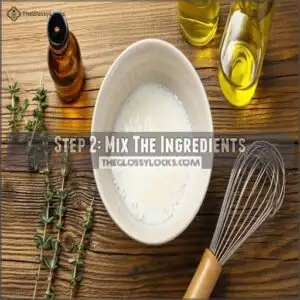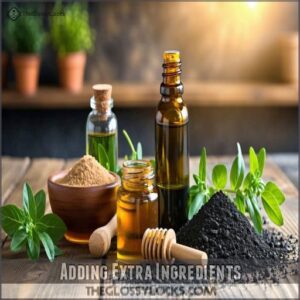This site is supported by our readers. We may earn a commission, at no cost to you, if you purchase through links.

You’ll want to start with castile soap as your base, then add carrier oils like jojoba or coconut to nourish those facial follicles.
Essential oils such as tea tree or lavender smell great and also provide antibacterial benefits.
Don’t forget extras like aloe vera or honey for extra skin-loving goodness. By mixing these natural beard wash routine ingredients, you’re ditching harsh chemicals and embracing a grooming approach that’s kind to your skin and the environment. Ready to transform your beard game?
Table Of Contents
- Key Takeaways
- Ingredients for Natural Beard Wash
- Benefits of Using Natural Beard Wash
- Making Your Own Natural Beard Wash
- How to Use Your Natural Homemade Beard Wash
- Storing and Shelf Life
- Customizing Your DIY Beard Wash
- Tips and Precautions
- Frequently Asked Questions (FAQs)
- How to naturally wash a beard?
- How do you make homemade beard wash?
- What natural ingredients help beard growth?
- What is the best beard wash routine?
- Can beard wash help prevent beard dandruff?
- Does natural beard wash stop beard itch?
- How often should men wash their beards?
- Will beard wash promote faster beard growth?
- Can beard wash improve beard hair texture?
- Conclusion
Key Takeaways
- You’ll craft a natural beard wash that’s gentler and more nourishing than chemical-laden products, by using ingredients like castile soap, carrier oils (jojoba, coconut), and essential oils that clean and moisturize without harsh chemicals.
- Your homemade beard wash can be customized to your specific skin and beard type, allowing you to experiment with different essential oil blends and carrier oils to address unique needs like hydration, softness, or sensitivity.
- You’ll save money and reduce environmental impact by creating your own DIY beard wash, controlling ingredient quality and avoiding unnecessary packaging while using affordable, plant-based ingredients that are kind to your skin and the planet.
- You’ll need to pay attention to proper storage and shelf life, using dark glass containers, potentially adding natural preservatives, and creating small batches to ensure your beard wash remains fresh and effective without spoilage.
Ingredients for Natural Beard Wash
When making a natural beard wash, you’ll need ingredients that clean, moisturize, and nourish without irritating your skin.
Essentials like castile soap, carrier oils, and optional essential oils work together to keep your beard healthy and fresh.
Castile Soap
Castile soap is a game-changer in your DIY beard wash. Made from vegetable oils, it’s gentle yet effective, cutting through dirt and oil without harsh chemicals.
You’ll find both liquid and bar types, with popular brands like Dr. Bronner’s leading the pack.
For sensitive skin, unscented versions work wonders.
Need alternatives? Look into African black soap for a natural twist.
Carrier Oils
Carrier oils are game-changers for beard wash. They moisturize, nourish, and balance your skin and hair.
Popular picks include jojoba, almond, and coconut oils—each offering unique benefits. Jojoba mimics natural skin oils, almond soothes irritation, and coconut deeply hydrates.
For the best blends, choose from a variety of beard care products. Mix and match the best carrier oils for blends that suit your beard type.
Store them in dark containers for freshness.
Essential Oils
Essential oils, like tea tree, peppermint, or lavender, add more than just fragrance to your beard wash. They provide antibacterial benefits, soothe irritation, and promote healthy growth.
Combine oils based on your skin’s needs—peppermint invigorates, while lavender calms.
Remember, they’re potent. Dilute with carrier oils and follow safety precautions.
Store blends in dark glass bottles to preserve potency.
Other Natural Ingredients
Beyond essential oils, other natural ingredients pack a punch in beard care.
Aloe vera’s uses include soothing itchy skin.
Shea butter benefits your beard with deep hydration.
Add honey’s role as a humectant to lock in moisture.
Don’t overlook activated charcoal or clay masks for cleansing impurities.
These elevate your natural beard wash into one of the best beard wash ingredients combos!
Choosing The Right Ingredients
When choosing natural beard wash ingredients, focus on quality.
Look for ingredient sourcing from ethical brands, especially for oils like jojoba or argan.
Consider your budget—castile soap is versatile and budget-friendly.
Tailor scent profiles with essential oils like sandalwood.
Keep allergy concerns in mind, avoiding irritants.
The best beard wash ingredients support natural beard care, nourishing without harm.
Benefits of Using Natural Beard Wash
Using a natural beard wash spares your skin and beard from harsh chemicals that can cause irritation or dryness.
Plus, it nourishes with rich, natural oils, keeping your beard softer, shinier, and healthier over time.
No Harsh Chemicals
Cutting out harsh chemicals from your routine is a game-changer for natural beard care.
Chemical-free options like natural beard wash protect sensitive skin, prevent irritation, and guarantee a safe, long-term outcome.
You control ingredient sourcing, swapping synthetic nasties for organic beard wash essentials like those found in natural beard wash products.
Plus, chemical-free grooming is kinder to the planet, reducing environmental impact while keeping your beard clean and healthy.
Nourishes and Moisturizes
A natural beard wash keeps your beard hydrated, soft, and shiny using nourishing ingredients.
- Jojoba oil locks in moisture, preventing dryness.
- Shea butter deeply hydrates, softening coarse hairs.
- Coconut oil boosts overall hydration and adds shine.
- Aloe vera gel soothes and moisturizes.
- Vegetable glycerin attracts water, keeping your beard healthy.
Using a Shea Moisture beard wash can help control beard dandruff and promote a healthy shine.
Promotes Growth
A natural beard wash can boost growth by stimulating follicles and improving blood flow to the skin.
Ingredients like jojoba and essential oils support the hair cycle by nourishing roots.
Combined with a good diet rich in beard vitamins, this routine enhances beard health.
These growth factors make it a must for any beard care routine focused on fuller growth.
Saves Money
- Cost comparison: Ingredients like castile soap and natural oils are affordable in bulk.
- Affordable alternatives: Skip overpriced, chemical-filled brands.
- Long-term savings: DIY beard wash lasts longer.
- Value for money: Customize formulas to suit your beard without extra costs. Using the right best beard shampoo ingredients is also essential for healthy beard growth.
Environmentally Friendly
Choosing a natural beard cleanser isn’t just good for you, it’s better for the planet too.
With eco-friendly ingredients and sustainable packaging, you’re reducing waste and your carbon footprint.
DIY beard wash lets you avoid unnecessary chemicals while supporting ethical sourcing.
Plus, plant-based options mean clean grooming without guilt—a win for your beard and the Earth!
Making Your Own Natural Beard Wash
Making your own natural beard wash gives you full control over the ingredients, ensuring it’s suited to your beard’s unique needs.
By combining simple, natural items like castile soap, carrier oils, and essential oils, you can create a product that’s both effective and gentle on your skin. natural beard wash and gentle on your skin.
Step 1: Measure The Ingredients
Before you start mixing, grab your measuring tools – spoons, cups, or a small scale – because accuracy matters.
Precise ingredient quantities guarantee your homemade beard wash works as it should.
Whether scaling recipes up or tweaking for variations, consistency is key.
Carefully measure your castile soap, carrier oils, distilled water, and natural ingredients. Exact ingredient quantities set the foundation for success.
Step 2: Mix The Ingredients
Grab a clean bowl and spoon, and start combining your natural ingredients.
Slowly add liquids first, like castile soap and water, followed by oils.
Stir gently to maintain a smooth consistency—no clumps allowed! Use a whisk for better mixing techniques.
Aim for a balanced texture that’s ready to lather. Homemade beard wash deserves precision and care!
Step 3: Add Essential Oils
With essential oils, you can customize your DIY beard wash’s scent and benefits. Add 10-15 drops of oils like lavender for relaxation or tea tree for cleansing. Blend combinations like peppermint and eucalyptus for freshness.
Using gentle, natural ingredients is key, as harsh soaps strip natural oils.
Watch for allergy concerns—always patch test.
Stick to the recommended usage amounts for safe, effective results in your beard wash recipe using natural ingredients.
Step 4: Store The Beard Wash
Once your homemade beard wash is blended, pour it into storage containers.
Use amber or dark-colored bottles to shield it from light. Label with the date and ingredients for easy tracking.
Shelf life is short—about a week—unless preservatives like Liquid Germall Plus are added.
Follow best practices by storing containers in cool, dry spaces to maximize freshness.
How to Use Your Natural Homemade Beard Wash
Using your natural homemade beard wash is simple and helps keep your beard clean, soft, and healthy. Follow a few easy steps to make the most of your DIY grooming routine without irritating your skin.
Step 1: Wet Your Beard
Start your beard care routine by soaking your beard thoroughly with lukewarm water.
The right water temperature opens pores, loosens dirt, and preps facial hair for washing.
Spend a moment ensuring the water reaches every layer—wet vs. dry makes a difference here.
A well-soaked beard sets the stage for effective cleaning, so don’t rush this pre-wash prep step!
Step 2: Apply The Beard Wash
Squeeze a small lather amount of your homemade beard wash into your palm—don’t overdo it!
Gently massage it into your beard, reaching the skin beneath. This application technique facilitates thorough cleansing and nourishment.
Adjust the wash frequency to suit your routine, and enjoy how this DIY beard wash supports clean, healthy growth.
Step 3: Rinse and Dry Your Beard
Rinse thoroughly with warm water—too hot could strip natural oils—leaving your beard clean but hydrated.
Pat your beard gently with a clean towel, avoiding vigorous rubbing, which can cause breakage.
Allow it to air dry briefly before applying beard oil to lock in moisture.
This simple beard wash routine sets the stage for healthy, soft, and well-conditioned facial hair.
Tips for Using Your Beard Wash
When using your DIY beard wash, follow these tips for the best results:
- Apply correctly: Use a pea-sized amount, gently massaging into your beard and skin.
- Rinse advice: Always rinse thoroughly to avoid residue that causes dryness or itching.
- Dry well: Pat your beard dry with a towel—don’t rub, as it can damage hair.
Keep it simple but consistent!
Storing and Shelf Life
Proper storage is key to keeping your natural beard wash fresh and effective. Always use a sealed, dark-colored container and store it in a cool, dry place.
Adding natural preservatives like Vitamin E or rosemary antioxidant can help extend its shelf life.
Saving you from making a new batch every week.
Choosing The Right Container
Picking the perfect container for your DIY beard wash is key.
Glass works best—amber jars protect natural ingredients. Plastic is okay but may absorb scents.
Choose a pump or squeeze bottle for easy use.
Size matters; smaller containers keep your recipe fresh.
Always label with the date and recipe details.
| Material | Pros | Cons |
|---|---|---|
| Glass | Eco-friendly, preserves oils | Breakable, heavier |
| Plastic | Lightweight, affordable | May leach chemicals |
| Metal | Durable, sleek design | Can react with contents |
| Amber Glass | Blocks UV light, ideal | Pricier than clear glass |
| Silicone | Flexible, reusable | Less common for liquids |
Keeping It Fresh
Keep your homemade beard wash fresh by storing it in amber or dark-colored glass bottles to block sunlight.
Use airtight lids for the best storage and add preservative options like Vitamin E or rosemary antioxidant to extend shelf life and prevent mold.
Watch for freshness indicators like changes in scent or texture, as natural ingredients can spoil quickly.
Shelf Life and Expiration
Your homemade beard wash won’t last forever, so understanding its shelf life is key. Natural ingredients can spoil quickly without preservatives.
Follow these steps:
- Use airtight, dark storage containers to block light.
- Check best-before dates on ingredients to avoid spoilage.
- Refrigerate for freshness but avoid freezing.
Discard any DIY beard wash showing changes in smell, texture, or color. This is crucial for avoiding spoilage. Pay close attention to changes in appearance.
Extending Shelf Life With Preservatives
Preservative options like Liquid Germall Plus can maximize the shelf life of your homemade beard wash, preventing spoilage and bacteria.
It’s great for extending freshness, particularly if you aren’t using it up in a quick manner like with shaving soap.
Best practices? Mix it carefully, follow storage tips like keeping it in a cool, dark place, and watch for safety concerns when handling preservatives like with shaving soap ingredients.
Customizing Your DIY Beard Wash
You can customize your DIY beard wash by adjusting the liquid base, experimenting with essential oils, or adding extra ingredients for specific benefits.
Tailor your recipe to suit your beard’s texture and your skin’s needs, ensuring a perfect match for your personal care routine.
This ensures a perfect match for your personal care routine.
Adjusting The Liquid Base
Getting the liquid base right in your homemade beard wash is key. Adjust consistency by tweaking water ratios or adding aloe vera for hydration.
Glycerin benefits sensitive skin, making it softer and smoother.
Castile soap and other liquid base options give flexibility.
To maintain skin pH balance, avoid harsh soaps and avoid harsh chemicals.
Experiment to create a gentle beard wash that fits your needs, perfecting your DIY recipes for a custom touch.
Experimenting With Essential Oil Blends
Switching up your beard wash recipe? Play with essential oils for unique scent profiles and benefits.
Blending techniques create oil synergy while keeping safety precautions in mind—start small to avoid overpowering scents.
- Brighten with peppermint or lemon for freshness.
- Add tea tree for soothing properties.
- Use sandalwood for a warm, earthy beard scent.
- Lavender brings calming vibes.
Adding Extra Ingredients
Take your beard wash recipe up a notch with ingredient combinations like honey for added hydration, activated charcoal for a deep cleanse, or vitamin E to boost shelf life.
These extras can bring unexpected benefits like softer hair or clearer skin.
Just remember safety precautions—test for allergies and balance scents with carrier oils and essential oils for the best results.
Considering Your Beard Type and Skin
Your beard type and skin concerns matter when crafting the perfect wash. A dry beard craves more moisturizing oils like argan, while oily skin benefits from lighter ingredients. Sensitive skin? Stick with gentle, soothing options like chamomile.
Tailor your wash to:
- Beard texture: Coarse needs more hydration; fine is less demanding.
- Skin sensitivity: Avoid harsh essentials.
- Oiliness levels: Balance hydration without greasiness.
- Beard wash frequency: Adjust based on your routine.
Tips and Precautions
Before you start using your homemade beard wash, take a few precautions to avoid skin irritation or allergic reactions.
Always patch test new ingredients on a small area of skin.
Stick to trusted recipes to prevent common mistakes.
Patch Testing
Before trying your homemade beard wash, always patch test. Dab a little on your inner forearm (test location), wait 24 hours (patch test timing), and look for redness or irritation (reaction severity).
If nothing flares up, you’re good to go!
For more information on proper beard wash patch test methods, consult online resources.
Sensitive skin? Double-check ingredients. Follow up care matters—rinse thoroughly if there’s any reaction. Stay beard-ready!
Allergic Reactions
Reactions can sneak up on you, even with natural products. Watch for red flags after patch testing: itching, redness, swelling, or rashes.
Allergic reactions vary based on ingredient safety and sensitive skin. When choosing products, consider using a beard care kit with gentle, natural ingredients.
- Avoid known allergens to prevent flare-ups.
- Check reaction severity if symptoms persist.
- Use products labeled for sensitive skin.
- Use antihistamines if necessary.
Skin Irritation
Skin irritation often stems from harsh ingredients or allergens in beard wash.
Allergy tests help spot irritation causes.
Opt for a gentle beard wash recipe using soothing remedies like aloe vera and chamomile oil. Sensitive skin calls for beard wash ingredients like jojoba oil and castile soap.
Prevention tips? Stick to natural, fragrance-free blends crafted for extra care.
Common Mistakes to Avoid
Avoid incorrect ratios—too much castile soap dries your beard, while over-diluting weakens cleansing power.
Essential oil overuse irritates skin, so stick to proper amounts.
Poor storage, like plastic bottles, degrades your beard; use amber glass. Watch ingredient incompatibility, like combining citrus oils with sensitive skin.
Small errors derail beard care, so follow these DIY grooming tips! Washing your beard only twice to three times weekly can make all the difference.
Frequently Asked Questions (FAQs)
How to naturally wash a beard?
Just like a gardener tends to delicate plants, you’ll nurture your beard with a gentle, natural wash.
Mix castile soap, jojoba oil, and essential oils, massaging into your beard to cleanse, moisturize, and revitalize your facial hair effortlessly.
How do you make homemade beard wash?
Mix castile soap, distilled water, jojoba oil, and essential oils in a clean bottle.
Massage gently into your beard, rinse thoroughly, and pat dry.
You’ll craft a personalized, chemical-free wash that nourishes your facial hair.
What natural ingredients help beard growth?
Rough stubble meets smooth skin’s potential with nature’s beard-boosting allies.
Peppermint oil, biotin-rich foods, and jojoba stimulate follicles.
Rosemary and saw palmetto spark your beard’s wild growth, transforming patchy landscapes into lush, robust territories.
What is the best beard wash routine?
You’ll want a beard wash that cleanses without stripping natural oils.
Opt for natural ingredients like castile soap, jojoba oil, and essential oils.
Massage gently, rinse thoroughly, and follow with a moisturizing beard oil for maximum beard health.
Can beard wash help prevent beard dandruff?
Nourishing, hydrating, soothing: beard wash tackles dandruff head-on.
By removing dead skin cells, balancing moisture, and using natural ingredients like tea tree oil, you’ll combat flakes and maintain a healthy, itch-free beard.
Does natural beard wash stop beard itch?
Natural beard wash tackles itch by hydrating skin, removing dead cells, and balancing moisture.
It soothes irritation with gentle, nourishing ingredients like jojoba oil and essential oils.
Providing relief and promoting healthier beard growth.
How often should men wash their beards?
Like a garden needs just the right amount of water, your beard craves balanced cleaning.
Wash 2-3 times weekly to remove dirt and oils without stripping natural moisture,
keeping your facial mane healthy and looking sharp.
Will beard wash promote faster beard growth?
You’ll see minimal direct impact on beard growth.
However, a well-formulated beard wash can create healthier follicle conditions, potentially supporting ideal beard growth by removing buildup, reducing inflammation, and nourishing skin with essential nutrients.
Can beard wash improve beard hair texture?
A natural beard wash can greatly improve hair texture by nourishing follicles with essential oils and moisturizing ingredients.
It softens coarse strands, reduces frizz, and promotes a smoother, more manageable beard through targeted hydration and gentle cleansing techniques.
Conclusion
Ultimately, crafting your natural beard wash routine ingredients is more than a grooming choice—it’s a commitment to healthier skin and hair.
With DIY recipes that harness the power of natural ingredients, you’ll transform your beard care from mundane to extraordinary.
By understanding each component’s role, experimenting with blends, and prioritizing your unique skin and hair needs, you’ll create a personalized beard wash that nourishes, protects, and celebrates your facial hair’s potential.
- https://www.mayoclinic.org/drugs-supplements-tea-tree-oil/art-20364246
- https://www.aromatics.com/blogs/wellness/the-power-of-citrus-oils
- https://howtotron.com/how-to-make-your-own-natural-homemade-beard-wash/
- https://beardoholic.com/diy-beard-wash/
- https://www.beardbeasts.com/blogs/news/homemade-beard-wash
















